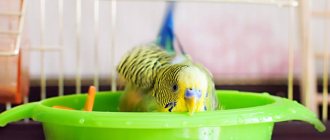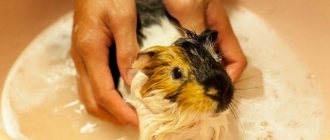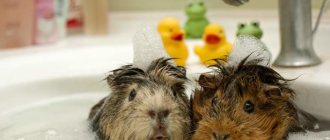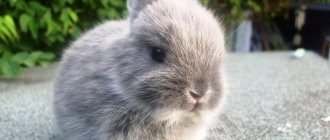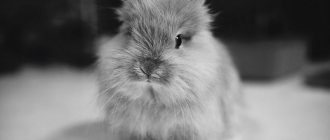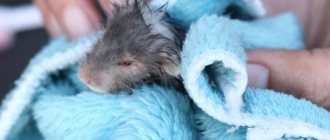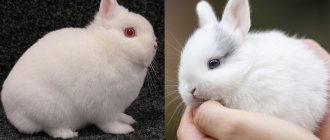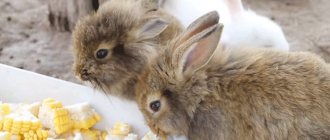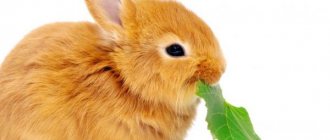The appearance of a playful little rabbit in the house is a great joy for all family members. But do not forget that a long-eared pet is not a plush toy, but a living creature that requires affection, love and proper care. To organize a proper life for an animal, you need to be aware of all the nuances of its maintenance. Hygiene procedures are a very important point.
It is worth noting that veterinarians do not recommend washing a rabbit and do not consider such a procedure mandatory. But sometimes it happens that you can’t do without swimming. This manipulation can be done at home, or you can immediately contact a professional groomer.
Is it possible to bathe a decorative rabbit?
A healthy rabbit does not need bathing at all. In nature, long-eared animals clean their fur themselves without immersion in water, and molting every six months allows them to get rid of heavily soiled areas. Experts cite a number of reasons why you should stop bathing your little ears:
- Bathing is stressful, which can negatively affect an already timid rabbit;
- Frequent contact with water harms the skin - it provokes an imbalance of the local flora, disrupts the water-salt metabolism of tissues;
- You can be injured during the procedure;
- Hard water and detergents wash away the natural shine of the coat, and regular bathing leads to baldness;
- There is a risk that the animal may freeze and catch a cold.
It is strictly forbidden to bathe pregnant females and rabbits.
When kept at home, there are times when animals are simply unable to clean their coats and they have to be helped to cope with this problem. It must be remembered that if your decorative pet still needs to be washed, then this must be done correctly and carefully.
Is it possible to dry a rabbit with a hairdryer?
To protect your animal from diseases and dry it faster after bathing, you can use a hairdryer. It is turned on to the minimum setting, the distance between the hair dryer and the pet should not exceed 50 cm.
Important! During drying, you can use special brushes to comb the fur.
Owners of decorative breeds should, whenever possible, do without using a hair dryer. This tool makes a lot of noise, which can only increase the animal’s stress from being in the water. In addition, rabbit skin is very sensitive to high temperatures, so when you turn on the hair dryer at maximum power, your pet can get burned.
Note! After washing your rabbit for several hours, it is important to avoid drafts. After visiting the bath, the animal is several times more likely to catch a cold. You should not swim in winter.
The owner himself decides whether to bathe the animal or not. It is important to assess the situation - whether this procedure is necessary. If your pet has diarrhea, then it will not solve the problem; you need to consult a veterinarian. Particular attention should be paid to the choice of hygiene products and bathing. For rabbit breeders, the well-being of their pet should be important, which will allow them to assess possible risks and make the right choice.
0 0 votes
Article rating
When is bathing really necessary?
Bathing a rabbit is justified only in certain cases:
- Heavy contamination of the animal after walking outside.
- Diarrhea.
- Getting harmful substances into the fur.
- The spread of urine or feces odor due to improper care of the rabbitry.
- In case of overheating (heat stroke).
- Contaminated fur that cannot be cleaned with a damp cloth.
Products that can be used for washing
First of all, it is necessary to prepare the room in which swimming will take place. Most often this is the bathroom, but you can bathe in other rooms, the main thing is that it is warm there and there are no drafts, for which you need to close all the windows. You can wash your pet in a sink, bathtub or large basin. You should also take rabbit shampoo and a large towel. If you don't have shampoo, good baby soap can replace it. Regular and especially laundry soap cannot be used. The bathing product must be natural, without any admixture of aggressive substances, fragrances, dyes and other harmful chemicals.
How to bathe a rabbit
If you decide to wash the animal, then you need to properly prepare for the procedure.
- Prepare a place for swimming - close the windows, eliminate drafts, remove foreign objects that may interfere.
- Prepare equipment (bathing container, towels for drying, specialized detergents, hair dryer).
- Decide on the method of procedure, taking into account the nature of the contamination - full or partial bathing.
It is worth remembering that when bathing, water or shampoo should not get into the rabbit’s nose or ears. And after washing, the animal should be well wrapped, wiped dry or blow-dried until completely dry.
What products can you use to wash your rabbit?
You need to bathe your rabbit in clean water. But if it cannot cope with contamination, then you should resort to using detergents. In pet stores you can buy special shampoos for bathing rabbits or shampoos for kittens, which are also suitable for eared ones.
Previously, it was advised to use regular baby soap, which does not contain parabens, fragrances, or fragrances. But cosmetics for people are not suitable for animals in terms of pH value - in humans it is 5.2-5.5, and in animals it is 7.0-7.52. This means that a rabbit can get burned from human soap.
How often can you bathe
All veterinarians are unanimous in their opinion - if there is no indication for washing a dwarf rabbit, then it is better not to wash it at all! You should resort to bathing only in extreme cases, when there is an urgent need for it.
How can you wash rabbits?
Depending on the degree of contamination, the washing method is selected:
- Full bathing in the basin.
Use if the animal is completely dirty. Fill the basin with water (36-40°C) 3-4 cm from the bottom, add one cap of shampoo, stir. The rabbit is placed in this container, its entire body is moistened with soapy water (except for the head), rinsed, the remaining detergent is washed off with clean water, wiped and dried.
- Bathing under the tap.
Unlike the first method, water is poured into the basin and shampoo is not added. The animal is placed in it, the fur is moistened with tap water, soaped, and then washed off with clean water. Wipe with a towel and dry.
- Partial wash.
If the animal is slightly dirty, wash only the dirty areas with soap. Typically, such manipulations are carried out with running water under a tap. This method, according to veterinarians, is more gentle and justified for regular care of eared animals.
- Dry technique.
In this case, a specialized waterless shampoo for rabbits, spray or powder is used, which is sprayed onto the fur, rubbed with a towel, and then simply combed out with a comb. They are often used before exhibitions or in the absence of water. It is worth noting that this method is not recommended for constant use, and it only helps if the animal is partially dirty.
Video Is it possible to bathe decorative rabbits at home?
Do I need to rinse my eyes?
While bathing, it is prohibited to wash your nose, ears and eyes, especially using detergent shampoos. On the contrary, it is recommended not to wet your head and protect it from water. Water and detergents can cause eye irritation, and if they get into the nose or ears, they can provoke the development of rhinitis, otitis media and other complications in the ENT organs.
But after washing, for prevention, the ears and eyes are wiped with cotton pads soaked in special veterinary lotions, which are intended for the preventive treatment of these organs. Their range in veterinary pharmacies is quite wide - they are selected individually for the animal.
General washing recommendations
If you are not confident in your own abilities, use the services of a groomer who bathes the rabbit without your participation. In other cases, follow the advice of experienced rabbit breeders:
- wash the animal together, since due to fear of water it can jump out, scratch and even bite;
- get used to bathing from an early age and gradually - first wash only the paws, then wet the back, but not with a large stream of water, but with a small stream;
- do not wet your ears or eyes with water, do not pour water on your face; when using the shower, check the nozzle to ensure that there are no unnecessary splashes on the sides (drops will get into your eyes and ears);
- if the rabbit has long hair and has formed tangles, then first they need to be trimmed and only after that water procedures are carried out, since wet clumps of wool are difficult to comb;
- immediately after washing, clean your ears with a cotton pad and a special lotion - movements should be light, do the same with your eyes;
- do not wash rabbits that are bearing offspring - stress and temperature changes lead to miscarriage;
- temporarily avoid water activities until the age of 1-1.5 months - babies still have weakened immunity, and their skin is too tender and sensitive;
- take into account the state of health - if the animal is sick, do not bathe it, wait until it recovers completely (otherwise the condition will worsen);
- Clean the cage in a timely manner - you won’t need to bathe it often.
Try to bathe your rabbit less often - it always creates a stressful situation for him, which is bad for his health. To do this, do not let him outside during bad weather, keep the room in which he lives clean, consult a veterinarian more often and get vaccinated, which is especially important on farms.
0
0
Copy link
How to dry your coat after bathing
After bathing the rabbit, it is necessary to dry it thoroughly. If this is not done, then there is a risk that the animal will catch a cold and may even die. To dry the eared fish, wrap it in a towel and then wipe it with dry sheets. In practice, it is permissible to use a hairdryer - it will help dry the animal faster and warm the chilled skin.
But we must not forget that the noise of an electrical appliance is additional stress for the animal. The hairdryer is usually turned on to the lowest setting and directed at the eared animal from a distance of more than 0.5 m, so as not to burn the animal’s delicate skin. When drying, you need to comb the fur using special brushes - this will prevent the formation of tangles.
How to dry your pet properly
Drying a bathed rabbit should be done correctly. First, the animal is dried with a soft towel, wrapped in a second one and left to sit alone for a few minutes.
Next, you can use a warm air stream from a hair dryer to dry. The device must be placed no closer than 5–6 cm from the animal and turned on at minimum power. As the animal dries, you can slowly comb it. A bristle comb is ideal for a short-haired pet; a slicker brush or a comb with sparse teeth is ideal for a long-haired pet.
Important! A hairdryer can only be used if the animal reacts calmly to the sound of the device operating.
If the rabbit begins to worry when the hair dryer is on, it is better to stop using the device. The animal can lick itself perfectly well on its own. But you can’t put it down on the floor; a wet pet can get hypothermic.
Afterwards, be sure to treat the rabbit’s ears with a special lotion. This is very easy to do: apply a little product to the sponge, distribute evenly and clean the ears. You can also clean your rabbit's eyes in the same way.
Are water treatments necessary?
Almost all veterinarians categorically prohibit such procedures, noting that rabbits are very clean and in nature rarely come into contact with water, so they take care of their fur by licking themselves with their tongues.
In addition, frequent bathing can damage the lipid layer of the skin, which undoubtedly affects the quality of the coat. This is especially true for show breeds.
A rabbit must be taught to bathe gradually, from a young age, since an unprepared animal, having experienced stress, may die from this procedure.
Rodents of this species do not really like water, although they can swim if such a chance arises. There is plenty of information in various sources on bathing rabbits, but there is no categorical prohibition, so you can bathe an ordinary or decorative rabbit in the following cases:
- got dirty while walking;
- gastrointestinal disorders;
- untimely cleaning of the place where the animal is kept (cage);
- unpleasant odor from the animal;
- fur stains that cannot be removed with a damp cloth;
- exposure to chemicals and household chemicals on the fur.
And if such a need arises, you can contact a specialist (groomer) to bathe your pet. If you decide to do this at home, ask someone to help you so that the rabbit, being frightened, does not jump out of the basin or sink and injure itself and the owner.
The following procedures are strictly prohibited:
- wash livestock rabbits, as miscarriage may occur under stress or due to temperature changes;
- bathe small rabbits, since they have very delicate skin and fur, a poorly organized lipid layer on the skin;
- use the shower;
- wet the face, eyes and ears - water that gets into the ears and eyes can cause an inflammatory process in the ears (otitis media) and in the eyes (conjunctivitis).
In general, you should not create stress for an animal, as this can have a detrimental effect on its life and health.
Can rabbits swim?
Rabbits live on land and run well. But they are not inferior in swimming. Rabbits do not need to jump into water, although they may well do so if there is danger.
You shouldn't teach a rabbit to swim either. This fun can turn into tragedy if water suddenly gets into your ears, nose or mouth.
By itself, the rabbit swims like a dog, and can stop and drift through the water without moving because... fluff (especially in females) easily keeps them afloat.
09:06
Can a rabbit swim?
Some rabbits even enjoy swimming. They throw themselves into the lake/sea/bath/basin of water. Such rabbits can be trained to do this as a team. But if the rabbit shows fear and fear, you shouldn’t do this!
Dry method
The dry method involves cleaning the rabbit's fur using waterless shampoos and sprays. Waterless shampoo is sprayed onto the pet's coat, rubbed in with your hand or a small towel, then the coat is combed out. The spray should be sprayed especially carefully so as not to get into the ears and eyes.
It is very convenient to use such products before exhibitions and in the absence of water, but they cannot completely replace regular bathing. In addition, the spray shampoo helps to comb long-haired animals and untangle mats. Spray with mink oil retains moisture well, smoothes the coat and protects the skin from drying out. Some sprays are preventative against skin parasites.
Another product that can be used when there is no water is dry shampoo or cleansing powder. Dry shampoo has good cleaning, deodorizing and absorbent properties. After it, the wool becomes shiny, fluffy and smells pleasant. It is sprinkled on the contaminated area, then combed out clean.
Just like a spray, it is used only when partially contaminated.
How to wash rabbits eyes?
These pets are very clean. Without visible problems and recommendations from a veterinarian, there is no need to rinse anything, but the eyes may water and fester. This indicates the presence of diseases (conjunctivitis) or debris (hay, dust, etc.).
If the need arises, you should first show the animal to a doctor. After examination, appropriate treatment is prescribed. For minor irritations, you can wash your eyes with infusion of chamomile, calendula, or furatsilin solution.
Drying wool
To prevent your pet from becoming hypothermic, it is necessary to dry it as quickly as possible. First, the rabbit is dried with towels, changing them as it gets wet. It usually takes 2-3 pieces to dry. If the animal is not afraid of noise, you can use a hair dryer for further drying. It is placed at a distance of 50 cm from the animal. The speed of air flow and its temperature are set to a minimum so as not to frighten the animal, as well as not to dry out or burn the rabbit’s delicate skin.
During the drying process, you need to comb your pet. For short-haired rabbits, soft brushes with bristles are suitable, while for long-haired rabbits, slicker brushes and combs with rotating teeth are suitable. If the animal is afraid of the hair dryer, let it dry and lick itself. In this case, do not lower the animal to the floor so that the animal does not become hypothermic and get sick.
It is worth noting that bathing long-haired rabbits begins with removing mats with scissors or a mat cutter, and only after making sure of their absence do they begin water procedures. If it is possible to do without scissors, then simply comb out the tangled fur with a furminator or a regular brush. Otherwise, it will be impossible to untangle the tangle that has fallen under water.
After bathing, as a preventive measure, you need to clean your ears and eyes with special lotions. To do this, apply a small amount of product to a cotton swab, evenly distributing it over the cotton pad, and starting from the outer corner of the eye, moving to the inner corner, with a light movement, clean it of impurities. And don’t forget to comb your pet to keep it looking neat.
To summarize, we can say that whether or not to bathe a pet is the owner’s decision. It is important to correctly assess the situation and decide what is best for the animal at the moment. Be sure to take into account the health status of the animal. If your rabbit has a gastrointestinal disorder, the first step is to consult a veterinarian for advice to find out the cause of the disease. And then, based on the animal’s well-being, decide on the issue of bathing it.
Always clean your pet's cage on time. Before walking around the house, remove household chemicals and substances that could stain your furry beauty’s fur coat. Minimize the likelihood of your pet's skin colliding with water. In fact, regular brushing 2 times a week will be quite enough for a rabbit.
Bathing the rabbit is in the next video.

